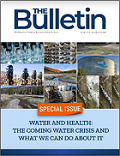
JUNE 2022
Reuse and Action Highlights
For more details about the following highlights and events, please visit the Recent and Upcoming Water Reuse Activities page.
Relevant Upcoming Activities and Events
- July 12—U.S. Bureau of Reclamation’s Desalination & Water Purification Research Program: Pitch to Pilot application closes.
- July 12—U.S. Department of State and USAID listening session on the U.S. Global Water Strategy 2022-2027 (registration link).
- July 13—Webinar: Water Infrastructure Funding in the BIL (registration link).
- July 20—Webinar: Upcoming WIFIA Funding Opportunities for Prospective Borrowers (registration link).
- August 23—2022-2023 Small Business Innovation Research Program Funding Opportunities Phase I Solicitation closes.
- August 31—National Priorities: Research on Disinfectants, Disinfection By-products, and Opportunistic Pathogens in Drinking Water Distribution Systems Request for Applications closes.
- Summer 2022—Potable reuse webinar for states. Please email Emily.Isaacs@pgenv.com to receive a registration link.
|
FUNDING AND INVESTMENTS
- EPA Announces $6.5 Billion in Funding for Water Infrastructure Projects – Established by the Water Infrastructure Finance and Innovation Act of 2014, WIFIA is an EPA grantee program that aims to accelerate investment in the Nation’s water infrastructure by providing long-term, low-cost supplemental loans for regionally and nationally significant projects. The notices of funding availability include $5.5 billion for the WIFIA program and an additional $1 billion for the State infrastructure financing authority WIFIA (SWIFIA) program. This round will prioritize funding in four areas:
- Increasing investment in economically stressed communities
- Making rapid progress on lead service line replacement
- Addressing PFAS and emerging contaminants
- Supporting one water innovation and resilience
- DOE and NAWI Award $17.7 Million to Accelerate Energy-Efficient Water Treatment Technology Development – The U.S. Department of Energy (DOE), in partnership with the National Alliance for Water Innovation (NAWI) Hub, announced the selection of 16 projects that will help the U.S. secure an affordable, energy-efficient water supply. Selected projects will develop innovative desalination and reuse technologies that can treat nontraditional water sources (e.g., brackish water, seawater, and industrial wastewater) and shrink the carbon footprint of the water-treatment industry. Find out more about the projects here.
- EPA Announces $18 Million for Training and Technical Assistance for Small, Rural, and Tribal Wastewater Improvements – $18 million is now available in federal funding to build the pipeline of technical assistance providers that can serve small, rural, and Tribal municipalities through the Clean Water Act Prevention, Reduction, and Elimination of Pollution Grant Program. This investment delivers on President Biden’s Justice40 initiative and will support technical assistance providers to help utilities improve vital wastewater management, including water reuse, that is essential to healthy communities. The funding will also elevate impact from Bipartisan Infrastructure Law (BIL) funding available to small, rural, and Tribal communities. For more information about this program and funding announcement, look here.
 |
PUBLICATIONS AND PRESENTATIONS
- Water & Health: The Coming Water Crisis and What We Can Do About It – In a special issue of their magazine, The Bulletin, the Santa Clara County Medical Association partnered with the region’s wholesale water supplier to produce a series of articles that address water reuse as a tool to combat climate change and environmental challenges. These articles, which are primarily written by and for physicians, help answer critical questions that doctors and their patients have about water quality and water reuse (Action 8.6: Develop Public Health Water Reuse Communication Tools).
- WE&T Feature Article: Building Resilience Through Reuse – The June issue of Water Environment and Technology features an article that underscores the importance of reuse as a resiliency tool for climate change and highlights trends, projects, and approaches to pursuing reuse projects. Additionally, the article highlights the WRAP as a platform and roadmap for reuse in the United States.
- WRAP Highlighted as an Example to Support Water Reuse Internationally – Mexico’s National Commission of Water (CONAGUA) hosted a webinar that was attended by over 200 people. The goal of the webinar was to normalize multi-benefit centralized water reuse by showcasing U.S. efforts as Mexico considers advancing similar efforts across the country. U.S. presentations featured the WRAP and two Texas case studies (El Paso and the East Fork Water Reuse Project), presented by EPA’s National Water Reuse Expert, Dr. Rabia Chaudhry, and Plummer Associates, respectively. Mexican officials presented activities and plans for water reuse in Mexico City (Xico), Monterrey, and Tijuana in collaboration with EPA’s U.S.-Mexico border program.
- Progress on WRAP Actions Represented at ACE22 – EPA’s Water Reuse Program was represented at the AWWA Annual Conference and Exposition (ACE22) in San Antonio. Actions highlighted included Action 3.1 on the REUSExplorer and Action 8.5 which supports technical assistance for small communities. Additionally, Radhika Fox, EPA’s Assistant Administrator for Water, toured the San Antonio Water Systems brackish water desalination facility in San Antonio Texas (pictured).
 |
SAWs CEO Robert Puente, EPA Assistant Administrator for Water Radhika Fox, and EPA Region 6 Administrator Earthea Nance on tour at SAWs Water Reuse Facility in San Antonio, Texas.
|
STATE REUSE REGULATION DEVELOPMENTS
- Regulating Direct Potable Reuse in California – The California State Water Board’s Division of Drinking Water is carrying out a series of legislative mandates regarding Direct Potable Reuse (DPR). DPR is the planned introduction of recycled water either directly into a public drinking water system or into a raw water supply immediately upstream of a drinking water treatment plant. This June, an expert panel released recommendations based on the draft DPR criteria.
- Update on Arizona Potable Reuse Rulemaking – The Arizona Department of Environmental Quality is in the early planning stages of beginning rule modification to provide a clear permitting process and regulatory standards for Direct Potable Reuse. See their latest stakeholder update here, courtesy of WateReuse Arizona, and sign up to get updates from the Arizona Department of Environmental Quality.
If you have questions about water reuse, progress or news on WRAP actions, or reuse activities that you would like EPA’s water reuse team to consider for inclusion in an upcoming monthly status update, please email waterreuse@epa.gov.
|